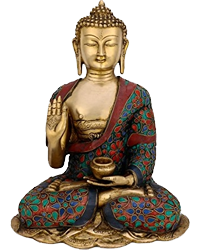By the time of the Gupta dynasty (c. AD 320-c. 600), Buddhism in India was being affected by the revival of Brahmanic religion and the rising tide of bhakti (a devotional movement that emphasized the intense love of a devotee for a personal god). During this period, for example, some Hindus were practicing devotion to the Buddha, whom they regarded as an avatar (incarnation) of the Hindu deity Vishnu.
During the Gupta period some monasteries joined together to form monastic centres (mahaviharas) that functioned as universities. The most famous of these, located at Nalanda, had a curriculum that went far beyond the bounds of traditional Buddhism. Nalanda soon became the leading centre for the study of Mahayana, which was rapidly becoming the dominant Buddhist tradition in India.
Though Buddhist institutions seemed to be faring well under the Guptas, various Chinese pilgrims visiting India between AD 400 and 700 could discern an internal decline in the Buddhist community and the beginning of the reabsorption of Indian Buddhism by Hinduism. Among these pilgrims were Fa-hsien, Sung Yün, Hui-sheng, Hsüan-tsang, and I-ching.
The accounts of these Chinese travelers provide invaluable information about Asian cultures from the Sasanian (Persian) empire in the west to Sumatra and Java in the east, and from Turfan in Central Asia to Kañchi in the south of India. In 399 Fa-hsien left China, crossed the Gobi (Desert), and visited various holy places in India. He then returned to China via Sri Lanka and Java, taking with him numerous Buddhist scriptures and statues. The most famous of the Chinese travelers was the 7th-century monk Hsüan-tsang. When he arrived in northwestern India, he found "millions of monasteries" reduced to ruins by the Huns, a nomadic Central Asian people. Many of the remaining Buddhists were developing their own form of Tantrism, an esoteric psychic-physical system of belief and practice. In the northeast, Hsüan-tsang visited various holy places and studied Yogacara, a Mahayana system, and Indian philosophy at Nalanda. After visiting Assam and southern India he returned to China with some 600 sutras.
After the destruction of numerous Buddhist monasteries in the 6th century AD by the Huns, Buddhism revived, especially in the northeast, where it flourished for a time under the Buddhist Pala kings (8th-12th century AD). These kings continued to protect the great monastic establishments (mahaviharas), building such new centres as Odantapuri, near Nalanda, and establishing a system of supervision for all such institutions. Under the Palas, Tantric Buddhism (i.e., Vajrayana) became the dominant sect. Adepts of this sect, called siddhas, identified nirvana with the passions, maintaining that one could "touch the deathless element with his body." Though some of its practices seemed excessive, scholars of this school sought to revalorize some of the most archaic elements in Indian religion. During this period, the university of Nalanda became a centre for the study of Tantric Buddhism and the practice of Tantric magic and rituals. Under the Pala kings, contacts with China decreased as Indians began to turn their attention to Tibet and Southeast Asia.
INDIA
Buddhism in India



